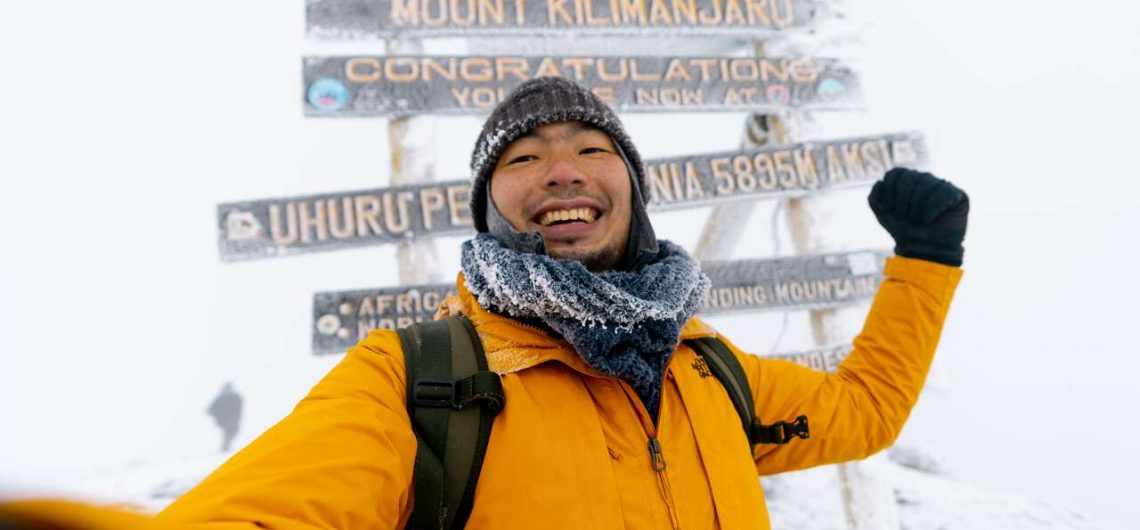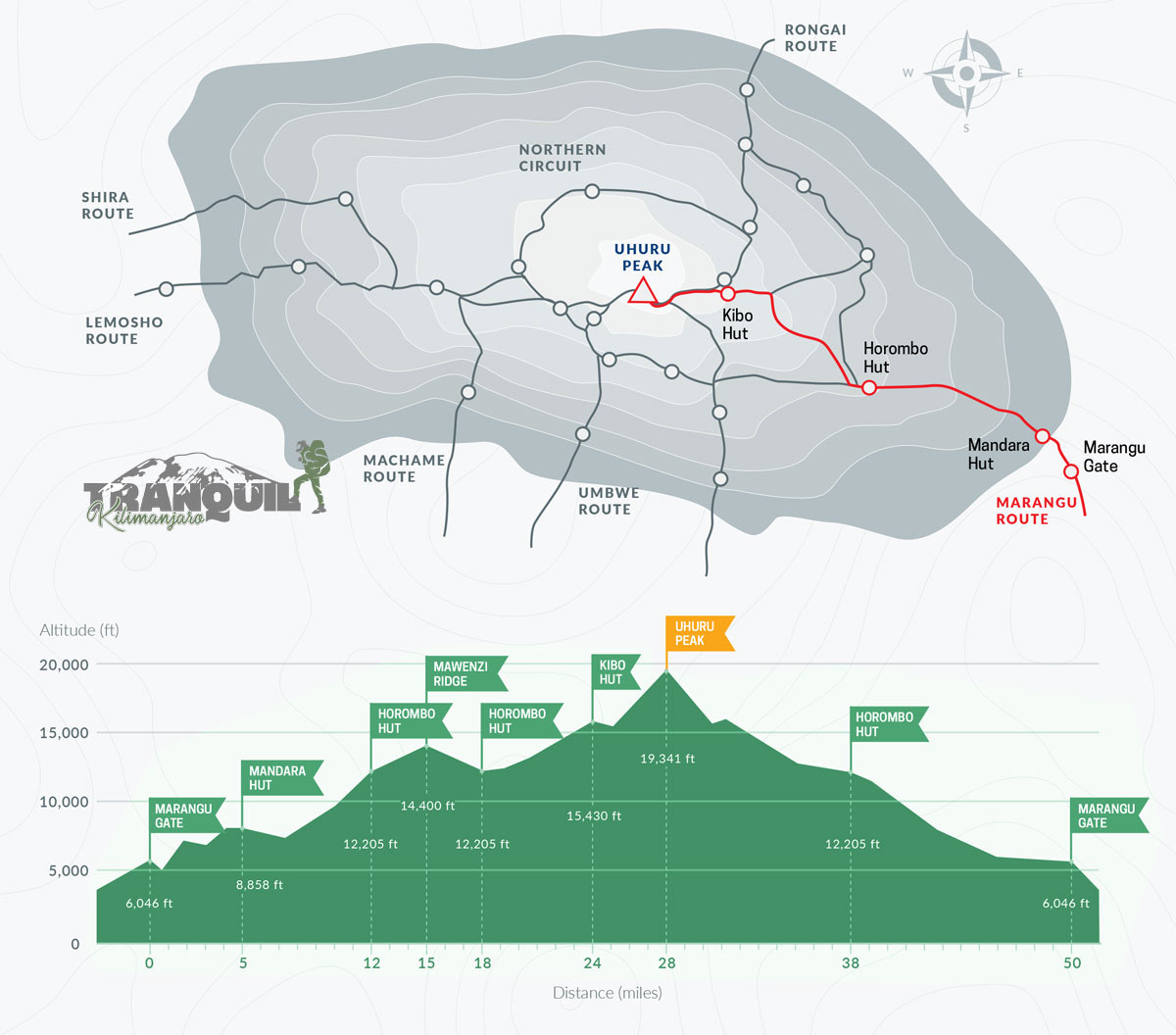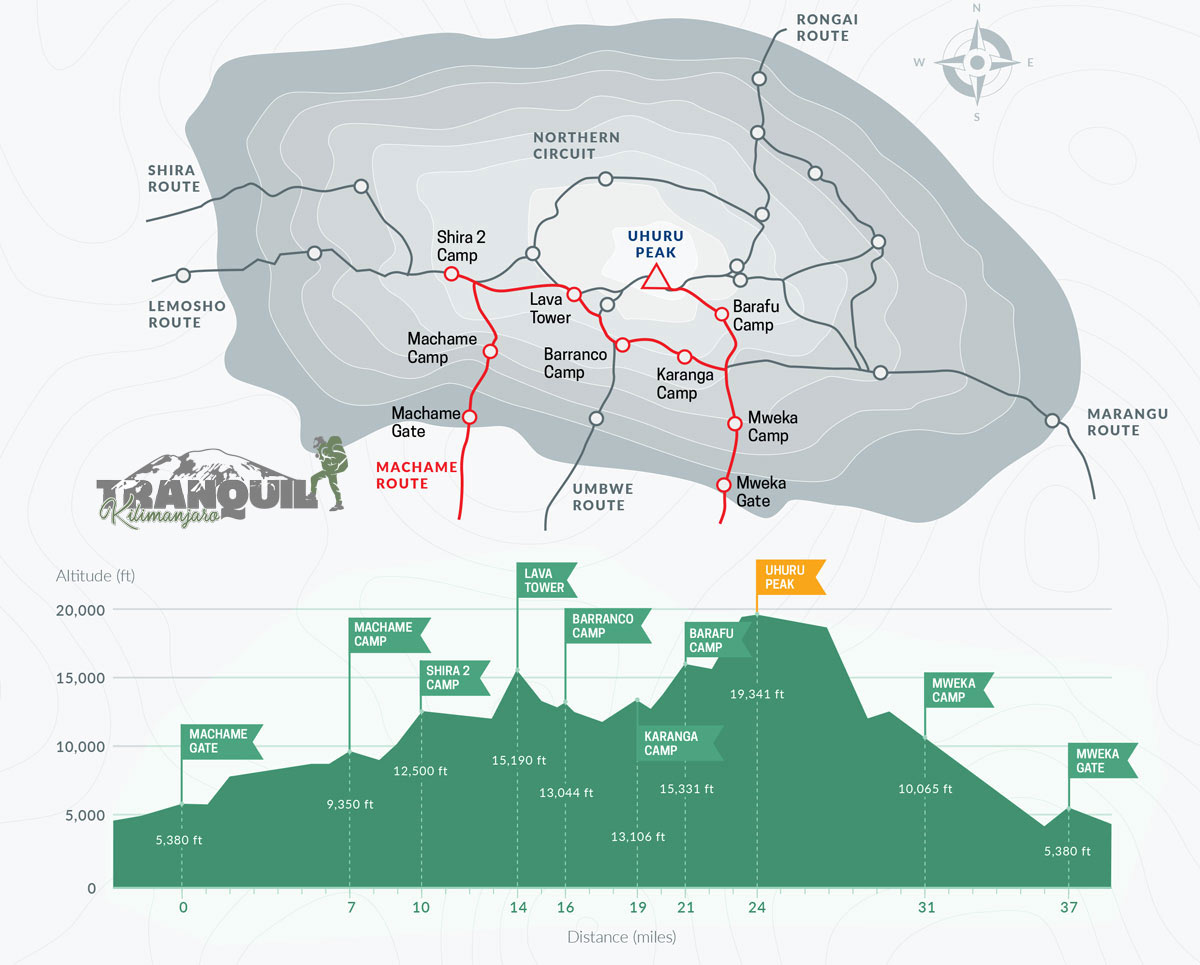So really the main thing or the main difference between the Machame route and the Marangu route is the length or the duration of time you’re going to be spending on the mountain, on the Machame route, you will need more days than Marangu route which is shorter. When it comes to the distance, on the Machame route, you will be covering about 36 miles and the Marangu route is a little bit longer, about 45 miles or so but you will need more days on the Machame Route because of the climbing up and down to achieve acclimatization.
The Machame route is known for being one of the routes with high success rates. And then I know that with the Marangu route, you really have to be a competent hiker, you have to be fit in order to make it.
Which is the better route for climbing Kilimanjaro?
Honestly, it depends on what you are looking for and what suits you best. If you are not accustomed to camping at high altitudes, you have a tight budget or you do not have enough time on your hands then the Marangu Route is the better option for you because it is shorter, takes fewer days to complete, and is more affordable. But if you have the time, you do not have budget restrictions, you want a more scenic route and you want a higher chance of reaching the summit at Uhuru Peak, then the Machame Route is definitely the better option for you.
- The Marangu Route: the only route that offers hut accommodation on the mountain.
- The Machame Route: the most popular route among climbers on Kilimanjaro.
Marangu Route
- Start: Marangu Gate from the east
- Finish: Marangu Gate
- Length of trail: 64 kilometers (39.8 miles)
- Length of trek: five to six days, the six-day option is better for people who require longer acclimatization
- Camps: Mandara Hut, Horombo Hut, and Kibo Hut Campsites
 Best time to climb Marangu Route
Best time to climb Marangu Route
Trekking trips are available year-round because it is the simplest route, though there are fewer of them in the off-peak months. June and December feature fewer hikers and moderate precipitation to avoid heavy traffic. If you can handle the severe rains, March is often wonderful for even less traffic. Read more about the Marangu Route
Machame Route
- Start: Machame Gate, west of Umbwe
- Finish: Mweka Gate at the end of Mweka Route
- Length of trail: 49 kilometres (30 miles)
- Length of trek: Typically 7 days, anywhere from 3 to 14 hours of hiking per day
- Camps: Machame, Shira, Barranco, Karanga, Barafu and Mweka
 Best time to trek Machame Route
Best time to trek Machame Route
Because Machame is more challenging, it’s recommended to avoid climbing Kilimanjaro during the wet season when circumstances are rougher, even if it is feasible to do so year-round. While there is a lot of traffic, the ideal months are from August through October. Read more about the Machame Route
Since it’s in fewer days and longer, you definitely need to kind of make sure that you’ve done some training beforehand. With that said, it still does have a very high success rate. Mount Kilimanjaro does have a fairly higher success rate compared to the other mountains of the 7 summits. But because you’re kind of going in more altitude every single day. Altitude sickness might be more of an issue because at high altitudes or at such high elevations, you want to give your body enough time to adjust to changes in elevation. And it feels as if we do the Marangu route, you don’t have that much time. So unless you have experience hiking at elevation, it will be a little bit more challenging.
Sleeping in huts is one of the major differences between both routes. On the Machame route, you will be sleeping in tents. So there are campgrounds that are established throughout the mountain. So every day we would go to a certain camp and then basically the porters will pitch your tent, that’s where you spend the nights. But that’s different on the Marangu route as you will actually be sleeping in dormitory-styled huts the entire time. some little beds which are like bunk beds and some regular beds, so in every single place that you stayed you definitely were in more of a bunker feel.
Compared to the Marangu route, the Machame summit’s success is higher. People have more time to acclimate because the Machame route has a more gradual ascent. As a result, they typically do not get altitude sickness.
I will point out that Machame’s descent is more difficult. Because Marangu descends more gradually, it is simpler to do so. The loose scree is often claimed to be skied down, but only if one wants to descend swiftly. You can zigzag down if you want to get down gradually. The Machame descent is a little more difficult, particularly from base camp until the last night. You are descending a lot of stairs and steps, which might be exhausting.
See also: Lemosho vs Machame Route, which route is the best on Kilimanjaro?
Climbing Kilimanjaro using Marangu vs Machame
It’s crucial for those who want to trek Kilimanjaro using the Marangu route to understand that it is a two-traffic route and that you ascend and descend on the same trail. But on the Machame route, you take the Mweka route to go down and the Machame route to go up. You will therefore be able to observe the mountain’s two sides.
There is also two-way traffic because the Marangu ascent and descent are in the same direction. People are stumbling over each other, talking to one another, and occasionally running into one another. However, Mweka is only for descending while Machame is solely for going up the mountain.
Which of these two well-known Kilimanjaro routes is ideal for your trekking tour? To be frank, your level of experience, available time, and personal preferences truly determine everything.
Here, we’ll take a deeper look at the Marangu and Machame routes, which, taken together, make up around 85% of all mountain visitors. Since each route delivers a distinctively different experience, it is important to do your research before choosing one.
1. Accommodation: Huts vs Camping Experience
The main distinction between the two itineraries is probably the Marangu hut experience and the Machame camping experience. Marangu has a vast network of well-designed huts, communal dining areas, and modern restrooms. Although the higher Horombo Hut includes a mix of dorm and quad shared rooms and Kibo is entirely dormitory type, the huts are often shared by 4 people. Both Horombo Hut and Mandara have clean restrooms with solar lights and flush toilets. The dining lodges are cozy, spotless, and a great location to gather with friends and escape the elements. The Marangu Route is the way to go if you’re not used to camping and want a bit more pleasant experience.
Even if you’re an experienced traveler and are considering visiting during one of the rainier seasons, this is still a wise decision because the huts are cozy and dry. If you’re looking forward to camping and this is a key part of the experience, think considering taking Machame or another less traveled route.
2. Marangu vs Machame Popularity and Traffic
With 45% of trekkers choosing the Machame Route as opposed to 40% choosing the Marangu Route, this route is the most popular. This wasn’t always the case but has gradually gained favor because it allows trekkers more time to acclimate and consequently somewhat higher success percentages. Both routes are popular with hikers, and they don’t offer as many opportunities for isolation as the less popular Lemosho, Shira, Rongai, Northern Circuit, and Umbwe Routes. The Tanzania National Park Service does a reasonably decent job of cleaning and keeping the trails clean (considering it’s a third-world country). On the summit day, when all the trails meet near the summit, you will still run into a fair amount of traffic even if you choose one of the less traveled ways.
3. Route length and trekking distance
The Marangu Route is 70 km and is normally done over 5 days, making the average daily hike a little bit longer. The Machame Route is 62 km and is typically hiked over 6 days. While the distances are shorter on the Machame route, there are more uphill and downhill climbs, thus it is not necessarily easier hiking, although one is better prepared for the summit day.
4. Acclimatization
Due to the longer travel time (Machame is a six-day route, Marangu is a five-day route), Machame provides a better opportunity for acclimatization. Either route can have an additional day added for acclimatization, and if Marangu is completed as a six-day trek, the chance for acclimatization is probably comparable to that of Machame. Even if the amount of time is the same, some would claim that Machame is a superior alternative because it takes hikers to a greater level and then back down for resting because of the proverb “climb high and sleep low.”
Given that the body can only acclimate so quickly (about 300m per day), and that additional acclimatization walks cannot make up for lost time, this issue seems to be pointless to me. Acclimatization is more difficult on the five-day Marangu route since you must ascend 13,000 feet (4,000 meters) in just three and a half days to reach the summit.
5. Scenery
The Machame route likely offers a modest advantage in terms of scenery, in large part because the Marangu retraces the same path in both ways, but the Machame route starts at the Machame Gate and ends at the Mweka Gate. Both routes, however, are picturesque and pass through the same variety of ecosystems, from tropical jungle to mountain heath to alpine to eventually summit or arctic. On the Machame Route, the Lava Tower site and the inclining Barranco wall stand out. While Mount Mewenzi, the third-highest peak in Africa and an extinct Kilimanjaro cone, can be seen beautifully from the Marangu Route.
6. Summit day
Though hardly by much, ascending from Machame will likely be simpler. Although it is still steep, the trail from Barafu camp to the summit ridge is perhaps a little bit better. Once the summit ridge is reached by the Machame route, the distance to the actual summit is reduced. Additionally, less time is needed on the summit ridge, where the climb’s peak elevation is located. Whatever distinctions there may be between these two routes, I don’t believe they should be used to choose one.
7. Summit success
The Machame Route has a higher summit success record of around 95% while the Marangu Route is almost 80%. Shira Route is 86%, while other routes like the Rongai and Lemosho routes are about 95%. In general, the length of time spent on the mountain is directly proportional to the success path (more time equals better acclimatization).
8. Cost and time
The “Coca-Cola” trail in Marangu is thus named for a good reason. It is the quickest and cheapest way to reach the summit. The price of climbing Kilimanjaro is probably more approachable and affordable on the Marangu route. The shorter travel times and the fact that fewer porters are required because camping gear does not need to be carried account for the lower expenses. We provide both itineraries, with Machame being a 7-day trip and Marangu being a 6-day program.
Coca-cola Route vs Whiskey route
The routes are referred to as Coca-Cola and Whisky, respectively. Why? That is what we sought to learn. The reason the Marangu route is known as the Coca-Cola route is that Coca-Cola used to be sold along the route. In response to the “Coca-Cola route,” the Machame route was nicknamed the “Whiskey Route” because the Machame is “tougher” than Marangu (Whiskey is stronger than Coca-cola soda).
The six commonly used routes on Kilimanjaro are Marangu, Machame, Rongai, Lemosho, Shira, Northern, and Umbwe to be more precise. The most popular routes on Kilimanjaro are Marangu and Machame.
Similarities between Marangu and Machame Routes
Both the Machame and Marangu routes approach the mountain from the south, making their way toward the summit, Uhuru Peak. The other similarity between these two routes is that they have existed on the mountain for a long time before the introduction of the newer and improved routes like the Northern Circuit route which is the longest one on the mountain taking a duration of 9 days, trekking Kilimanjaro and Lemosho Route which is an improved version of the Shira Route. Because you only see wildlife in the forest and both Marangu and Machame have the same type of forest, the wildlife can be found in relatively similar habitats on both routes. Primates and birds make up the majority of the wildlife on the mountain. Take the Rongai Route if you want an opportunity to observe more animals, as it looks down over Amboseli National Park. On this path, you might encounter elephants and other wildlife one in five times, but only up close.
Related: Lemosho vs Marangu Route, comparing the newer and older routes of Kilimanjaro
Is Machame Route harder than Marangu Route?
No, actually Machame is easier because it was properly designed to address acclimatization methods. You spend most of your days climbing high and sleeping low, which is what you should strive for on any high-altitude walk. After reaching the summit, you begin your descent along the Marangu trail. Every day, you ascend and descend with Machame, which helps you acclimate to the altitude and provides a little bit of variety. Different areas of your legs are used.
Is Machame’s summit success higher than Marangu Route’s
Yes, more people succeed in summiting Machame than by the Marangu route. People have more time to acclimate because the Machame route has a more gradual ascent. As a result, they typically do not get altitude sickness.
Is Marangu Route easier to descend than using Machame’s Mweka Route to descend?
Yes, since the Mweka Route is used as the descent route for Machame, then Machame’s descent is more difficult, particularly from base camp until the last night. You are descending a lot of stairs and steps, which might be exhausting. The Marangu route on the other hand descends more gradually, it is simpler to do so. The loose scree is often claimed to be skied down, but only if one wants to descend swiftly. You can zigzag down if you want to get down gradually.
Why do people choose the Marangu Route over the Machame Route?
Price and comfort seem to be the primary factors here.
It is a more affordable trek because Marangu may be climbed in as little as five days. Some tour companies claim that because their journey is quicker, you will save money and have more time to go on safari, etc. It is not wise to rush things, which could be risky. Plan extra days to aid with acclimatization for trekkers. This, in my opinion, is really crucial as safety should come first. Still, Machame is a few days longer even when the proper number of days are used. So, the price is higher.
Additionally, it is warmer because you sleep in huts on the Marangu route. You camp in tents along the Machame trail.
Why Machame Route is better than Marangu Route
Machame is the better option because the scenery is more scenic and diversified. There are more than five temperature zones on Kilimanjaro, and the Machame path allows you to visit every one of them as well as their sub-zones. On the Machame route, you can witness farming areas, mountain rainforests, heath, and montane forests, alpine deserts, moon deserts, and tundra. On Marangu, the only landscapes visible are the alpine desert, montane forest, and agriculture zones.
Glaciers can also be seen on the Machame route earlier than on the Marangu route, around 4,600 meters. The majority of the glaciers, including Heim Glacier, Decken Glacier, and Kirsten Glacier, can be seen from here when you come very close to Western Breach. On Marangu, glaciers are only just becoming visible by the fourth day, and your tent for the fourth night is right below them. However, once you reach a height of 5,000 meters, no matter which route you take, the glaciers are the same.
![]()




Comments